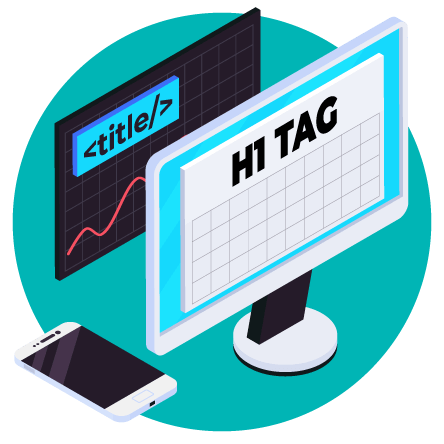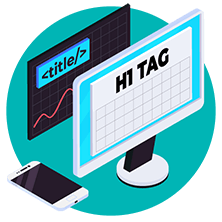Imagine you’ve just landed on a Google search engine results page (SERP) for the query, “best SEO tactics”. In the corresponding results, you’ll see blue titles paired with short write-ups that explain what each proposed result is about.
These titles and descriptions will navigate you through your query, helping you understand which website to visit to get the information you need.
In SEO, we call these writeups title tags and meta descriptions. When optimised correctly, both tactics offer impressive SEO value that can greatly improve your website’s organic visibility and traffic.
Title tags specifically offer clear, engaging, and click-worthy search results that improve website engagements and traffic. Because search engines like Google account for more than 86% of global search traffic, mastering title tags is an essential part of SEO.
In this article, we’ll teach you how to write successful SEO title tags, find target keywords for titles, and explain why it all matters. At the end, we’ll provide some SEO title tag best practices alongside SEO title tag generators to help your process.
Interested in learning more SEO tips and tricks? Check out our latest range of SEO guides:
What is an SEO title tag?
An SEO title tag is a digital marketing tool that shows search engine users what they can expect from a web page.
In the following example, you can see the SEO title tag in purple. This title tells a searcher that ALT Agency offers web design services in Birmingham. In the following meta description, more information is given as to what kinds of services users can expect to find on this page.

Title tags show up in SERPs and on posts that are shared on social media. Title tags will also be shown on browser tabs and other varied places around the web.
It’s important that you write your own title tags.
If you neglect to do so, Google will generate them for you, but this often leads to incorrect information being displayed.
Why are SEO title tags important?
Title tags are important because they give users a reason to click through your post from a SERP.
As well, title tags are used by Google and other search engines to determine what your webpage is about and how it should be ranked.

A little more about why Title tags matter…
Effective title tags explain the webpage in a concise and accurate manner so that users get the information they need more quickly. If you are using website title tags correctly, you’ll benefit from increased web traffic, brand reach, and overall SEO.
Tag vs. title: What’s the difference between title tags and H1-tags?
Title tags are different from H1 tags because they are shown in search result snippets, whereas H1 tags are shown on the webpage itself.

H1 Tags vs Title tags
In an HTML format, the page title shows up in the
section and the H1 shows up in the < body > section.When designing a website for SEO, you should include both H1 and title tags within your copy. Both tags serve to show search engines and customers what your webpage is about but remember that only your title tag shows up in search.
Common SEO title tag questions
Whilst very important yet simple to do, Title tags can cause confusion for some, so this handy title tag FAQ area will provide answers to some of your common title tag questions.
Read on below to find answers to your most burning title tag questions and get your SEO campaigns off to the right start.

Title Tag FAQS
- What is Title Tag in SEO? A title tag is a piece of HTML that displays the title of a webpage. Title tags are shown in search engine results pages (SERPs) as a headline that can be clicked. They have a big impact on SEO, social sharing, and click-through rates.
- How do you write a title tag for SEO? To write a title tag for SEO, you need to conduct keyword research and adhere to length guidelines (usually 50-60 characters). Your title should provide a concise and accurate description of what a user can find on your page and should promote engagement.
- Do title tags affect SEO? Title tags are essential for successful SEO. Poorly written title tags can result in lost user traffic and competitors taking your search result spots.
- How do you separate keywords in a title tag? Keywords can be separated with hyphens (-) or pipes (|). This will help users scan your title tag and allow you to rank for different keywords.
How to write effective SEO title tags
It’s not enough to just write any old title tag, you need to write effective title tags that get clicked and bring traffic to your website.
SEO title tags help search engines and users understand what your web pages are about. When done correctly, they can be impressive drivers of website traffic and have a big impact on your SEO.

Effective title tags
Good SEO title tags should be:
- Short (50-60 characters)
- Focused on user-intent
- Include keywords at the start
1. Use keywords in title tags
Keywords are an essential part of a successful SEO strategy. By using keywords that your ideal customers are likely to use in search, you turn up in more qualified search results.
Search engines put more weight on the words at the beginning of a title. So, it’s important to place your keyword at the start of your title if you want to rank for that word.
This graph from ahrefs shows the effectiveness of keywords in SEO title tags.
What is a target keyword for a title tag?
When choosing a target keyword for your title tag, conduct keyword research to find low-competition, high-volume keywords that your customers will be using to find your business.
According to Moz, 8% of keywords are phrased as a question, and data from ahrefs shows that 29% of high-volume keywords consist of three or more words.
Consider using longtail and shorttail keywords in your SEO titles. Once you’ve established a target keyword, find longtail variations that you can also leverage.
When using multiple keywords in an SEO title tag, use an SEO page title separator such as a hyphen (-) or a pipe (|). In the below example, we’ve used the keywords “quick SEO wins” and “ALT Agency” and the SEO page title separator pipe for our quick SEO wins blog.
2. Consider local SEO in title tags
Title tags can be an important part of your local SEO rankings.
For example, consider a user searching for SEO services in Birmingham. If ALT Agency wants to rank, we need to optimise our title tags to entice a local audience.
In the below example, we’ve used keywords such as “SEO agency Birmingham” and “SEO company Birmingham” to capture these searches.
In Whitespark’s 2020 Local Search Ranking Factors Survey, title tags in Google My Business came in as the 13th most important ranking factor. In a list of 122 factors, 13 is noteworthy– so don’t miss this step.
How to optimise title tags for local SEO
First, don’t use page-specific descriptors like “Home” or “About”. When writing local SEO title tags, use keywords that will drive users towards products or services you want them to see. As well, be sure to use your location to get the full benefit of local SEO title tags.
For example, if you’re a yoga studio, then the phrase “yoga studio” should be in your title tag. If you’re a yoga studio in Birmingham, then you should be using “yoga studio Birmingham”.
Tips for effective local SEO title tags:
Use keywords in title tag
Include your location
Make your title tag engaging
3. Add emotion in SEO title tags
Studies have shown that people rely on emotions, rather than information, to make most of their decisions. Emotional content has been shown to perform twice as well as rational content in advertising.
Adding an emotional hook to your SEO title tag will give users a reason to click on your webpage.
When writing emotional title tags, consider words and phrases that entice users. Words such as Amazing, Complete, Best, and Only can establish trust and proficiency in your brand.
As well, words that inspire curiosity should also be considered. Try phrases such as, “The 4 best ways to…” or clickbaity titles such as “X reasons why…” or “The last… you’ll ever need.”
Questions are another great way to embed emotion into your title tags. Consider using rhetorical or open-ended questions that users will want to be answered. Questions such as, “Do you know why your website isn’t getting the traffic it deserves?” or, “Looking to improve your online web traffic?” can draw users into your content. These words and phrases can also be used in SEO friendly blog titles to get higher SEO ratings on your website.
4. Include brackets and parentheses in SEO title tags
Brackets and parentheses can help break up your title tag and improve online readability. Some studies have shown that brackets and parentheses can also improve click-through rates.
Brackets act as a sneak preview of the content on your web page. By giving users a taste of what’s to come, you can increase the likelihood of them clicking on your search result.
Examples of brackets and parentheses in titles:
[Infographic] 2020 and beyond: eCommerce trends and stats
SEO Title Tags (A Guide to Writing Successful Title Tags)
10 Actionable SEO Tips (That Work)
This graph from Backlinko shows the importance of brackets in headlines and tilte tags.
5. Include numbers in your SEO title tags
Numbers are specific and they stand out. They also imply the existence of a listicle which is often easier to read and more scannable.
Titles that begin with a number see considerably higher click-through rates, so consider using numbers in your SEO title tags.
You can use numbers in your title tags to indicate a list, such as, “5 ways to…” or, “The top 10 things you didn’t know…”.
You can also use numbers to indicate a sale or discount, such as, “Best Running Shoes (20% off)” or, “Custom Wedding Dresses (Only 10 Left)”.
Below you’ll see some of the ways we’ve used numbers in our blog titles and SEO title tags.
SEO title tag best practices
As you know by now, title tags are key to SEO and there are a number of ways that title tags can be written to help benefit your SEO.
With title tags comes best practices that you should adhere to, this will help ensure you get the most from your SEO and title tags.
Read on below to discover the best tile tag practices.

Here are a few important things to remember when writing your SEO title tags:
- Use your keyword at the start of your title
- Use SEO title page separators like hyphens and pipes
- Add emotion to your title to hook your reader
- Use your location when optimising for local SEO
- Use brackets or parentheses to improve readability
- Consider clickbait tactics in your SEO titles
- Use numbers in your title tags to increase click-through rates
- Make sure title tags are included on every webpage
- Make sure all title tags are unique (duplicates can be a problem for your SEO)
- Write for humans, not search engines
- Ensure your overall SEO and web design is optimised
What will my title look like in SERP?
Now that you know how to create a well-optimised SEO title tag, it’s time to test your work.
An effective SEO title tag should be clear, actionable, engaging, and contain your target keywords.
It is also important that your title is not cut off or unreadable, so be sure to test different lengths of titles and choose one that is easiest to read.

What your title tag will look like
You can use the following SEO tools to check your title tags:
SEO title tag generators
Now that you know how to create a well-optimised SEO title tag, it’s time to test your work.
An effective SEO title tag should be clear, actionable, engaging, and contain your target keywords.
It is also important that your title is not cut off or unreadable, so be sure to test different lengths of titles and choose one that is easiest to read.

SEO title tag generators for you to use
If you’re new to the world of SEO, you may want to use a title tag generator to get started. Title tag generators can be found online and usually require your URL, keywords, and page titles.
Here are a few SEO title tag generators that you can use:
Final thoughts on SEO title tags
Now that you know how to create a well-optimised SEO title tag, it’s time to test your work.
An effective SEO title tag should be clear, actionable, engaging, and contain your target keywords.
It is also important that your title is not cut off or unreadable, so be sure to test different lengths of titles and choose one that is easiest to read.

A few final thoughts on SEO title tags
Title tags can improve your organic website traffic and make your website visitors stay longer.
They are also an important part of your SEO ranking which can impact your sales.
While you don’t need to invest in an SEO expert to write effective title tags, you do need to consider your users and write with their intent in mind.
From there, it’s all about A/B testing your content and seeing which tactics work best.
It may be that your customers prefer titles with numbers, while another business may see more success with brackets or parentheses. No matter what you choose, test, re-test, and test again.
Looking for an SEO agency in Birmingham? Our team of experts would love to help you transform your website into a high-powered sales machine. Contact us to learn more.
Read the other parts in this series, right here:
Part 1: What is SEO and how does it work? A complete guide to successful SEO
Image credits:
Business photo created by creativeart – www.freepik.com
Designed by macrovector / Freepik



 Dec 08, 2021
Dec 08, 2021 














 Contact us
Contact us 
